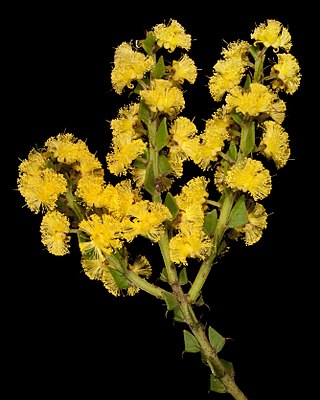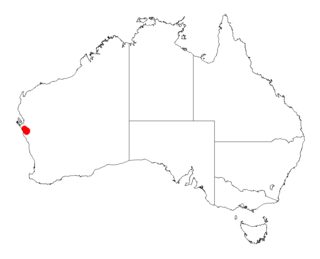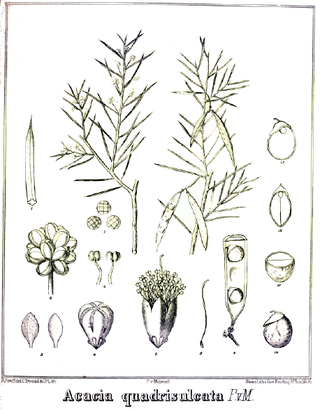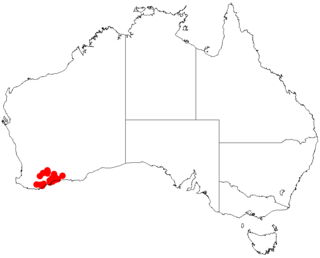
Acacia truncata, commonly known as the angle leaved wattle or west coast wattle, is a coastal shrub in the family Fabaceae, with a native distribution along the southwest coast of Western Australia. A specimen of this wattle was part of an early European botanical collection, perhaps the first from Australia.

Acacia applanata, commonly known as grass wattle, is a species of flowering plant in the family Fabaceae and is endemic to the south-west of Western Australia. It is an erect, grass-like shrub or subshrub with only a few phyllodes, continuous with the branchlets, and up to 4 racemes of spherical heads of 10 to 20, usually golden flowers, and curved, crust-like pods up to 30 mm (1.2 in) long.

Acacia desertorum is a shrub belonging to the genus Acacia and the subgenus Juliflorae that is endemic to western Australia.

Acacia sibina is a species of tree or shrub belonging to the genus Acacia and the subgenus Juliflorae the is endemic to parts of western Australia.
Acacia blaxellii, also known as Blaxell's wattle, is a shrub belonging to the genus Acacia and the subgenus Phyllodineae endemic to Western Australia.

Acacia chrysocephala is a shrub belonging to the genus Acacia and the subgenus Phyllodineae.

Acacia concolorans is a shrub belonging to the genus Acacia and the subgenus Phyllodineae that is endemic to Western Australia.

Acacia lanceolata is a shrub belonging to the genus Acacia and the subgenus Phyllodineae and is endemic to a small area of western Australia.

Acacia nervosa, commonly known as rib wattleribbed wattle or perfumed wattle, is a shrub belonging to the genus Acacia and the subgenus Phyllodineae.

Acacia pachypoda is a species of shrub in the family Fabaceae. It is endemic to south western Australia.

Acacia plautella is a shrub belonging to the genus Acacia and the subgenus Phyllodineae that is endemic to a small area along the coast of western Australia.

Acacia quadrisulcata is a shrub of the genus Acacia and the subgenus Phyllodineae endemic to Western Australia.

Acacia robiniae, commonly known as Robin's wattle, is a shrub of the genus Acacia and the subgenus Phyllodineae that is endemic to south western Australia.

Acacia simulans is a shrub of the genus Acacia and the subgenus Phyllodineae that is endemic to south western Australia.

Acacia sphenophylla is a shrub of the genus Acacia and the subgenus Phyllodineae that is endemic to a small area in western Australia.

Acacia dissona is a shrub of the genus Acacia and the subgenus Plurinerves that is endemic to an area of south western Australia.

Acacia donaldsonii is a shrub of the genus Acacia and the subgenus Plurinerves that is endemism in an area of south western Australia.

Acacia pharangites, commonly known as Wongan gully wattle, is a shrub of the genus Acacia and the subgenus Plurinerves that is endemic to the Wongan Hills of south western Australia and is listed as endangered according to the Environment Protection and Biodiversity Conservation Act 1999.

Acacia subsessilis is a shrub of the genus Acacia and the subgenus Plurinerves that is endemic to an area of western Australia.

Acacia tetanophylla is a shrub of the genus Acacia and the subgenus Plurinerves that is endemic to an area of south western Australia.






















